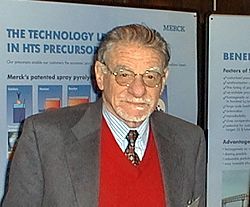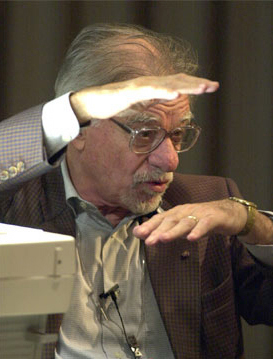K. Alex Müller facts for kids
Quick facts for kids
Karl Alexander Müller
|
|
|---|---|

Müller in 2001
|
|
| Born | 20 April 1927 Basel, Switzerland
|
| Died | 9 January 2023 (aged 95) Zürich, Switzerland
|
| Nationality | Swiss |
| Alma mater | ETH Zürich |
| Known for | High-temperature superconductivity |
| Spouse(s) | Ingeborg Marie Louise Winkler (m. 1956; 2 children) |
| Awards | Marcel Benoist Prize (1986) Nobel Prize in Physics (1987) Wilhelm Exner Medal (1987) EPS Europhysics Prize (1988) |
| Scientific career | |
| Fields | Physics |
| Institutions | IBM Zürich Research Laboratory University of Zurich Battelle Memorial Institute |
| Thesis | Paramagnetische Resonanz von Fe3+ in SrTiO3 Einkristallen (1958) |
| Doctoral advisor | Georg Busch |
| Doctoral students | Georg Bednorz |
Karl Alexander Müller (born April 20, 1927 – died January 9, 2023) was a Swiss physicist. He won the Nobel Prize in Physics in 1987. He shared the prize with Georg Bednorz. They won for their important work on superconductivity in ceramic materials.
Contents
About Karl Alexander Müller
Karl Alexander Müller was born in Basel, Switzerland, on April 20, 1927. His family soon moved to Salzburg, Austria. Later, he and his mother moved to Dornach, near Basel. They then moved to Lugano, where he learned to speak Italian well. His mother passed away when he was 11 years old.
In 1956, Müller married Ingeborg Marie Louise Winkler. They had a son, Eric, in 1957. Their daughter, Sylvia, was born in 1960.
His Education Journey
After his mother's death, Müller went to school at the Evangelical College in Schiers, Switzerland. He studied there from 1938 to 1945. He earned his baccalaureate, which is like a high school diploma.
Müller then studied Physics and Mathematics at the Swiss Federal Institute of Technology (ETH Zürich). He was taught by Wolfgang Pauli, a very famous physicist. After getting his first degree, he worked for a year. Then he went back to ETH Zürich to get his PhD. He finished his PhD thesis in 1957.
His Career and Work
Müller started working at the Battelle Memorial Institute in Geneva. He quickly became the manager of a group that studied magnetic resonance. During this time, he also taught at the University of Zürich.
In 1963, he joined the IBM Zürich Research Laboratory in Rüschlikon. He stayed there until he retired. He also continued to teach at the University of Zurich. He became a professor there in 1970. From 1972 to 1985, Müller was the manager of the physics department at IBM. In 1982, he became an IBM Fellow, which is a high honor for scientists at IBM. He also received special degrees from several universities.
His Research Discoveries
For his first university degree, Müller studied the Hall Effect in a material called gray tin. This material is a semimetal, which means it conducts electricity, but not as well as a metal.
Before starting his PhD, he worked on a large display system called Eidophor. This system was used to project images.
At IBM, Müller spent about 15 years studying materials like SrTiO3 (strontium titanate) and similar compounds. These materials are known as perovskites. He looked at how their color changed when light hit them (called photochromism). He also studied how their atoms were connected and how they changed their structure at different temperatures. He wrote a book about some of his important findings.
His Passing
Karl Alexander Müller passed away on January 9, 2023. He was 95 years old and died in Zürich.
Winning the Nobel Prize
In the early 1980s, Müller started looking for materials that could become superconductive at warmer temperatures. Superconductors are materials that can carry electricity with no loss of energy. At that time, the highest temperature for superconductivity was about 23 K. This is very, very cold.
In 1983, Müller asked Georg Bednorz to join him at IBM. They worked together to test many different oxide materials. Some experts thought their idea was strange. But in 1986, Müller and Bednorz made a big breakthrough. They found that a material called lanthanum barium copper oxide (LBCO) became superconductive at 35 K. This was a huge jump! For 13 years, the highest temperature had been stuck at 23 K.
This discovery sparked a lot of new research. Scientists around the world started looking for even warmer superconductors. This led to the discovery of materials that could superconduct at much higher temperatures, like 92 K and 107 K.
Müller and Bednorz shared their discovery in a science magazine in June 1986. Soon after, other scientists confirmed their results. A few months later, another scientist achieved superconductivity at 93 K. This led to a huge meeting of physicists in 1987, sometimes called the "Woodstock of physics". Müller was a main speaker there.
In 1987, Müller and Bednorz were awarded the Nobel Prize in Physics. It was the fastest Nobel Prize ever given after a discovery was made.
Other Awards and Honors
- Honorary degree from the University of Pavia, 1987.
- Honorary degree from the Norwegian University of Science and Technology, 1992.
See also
 In Spanish: Karl Alexander Müller para niños
In Spanish: Karl Alexander Müller para niños


